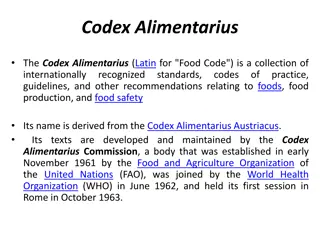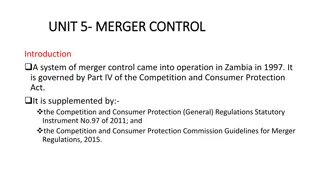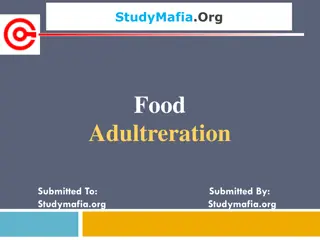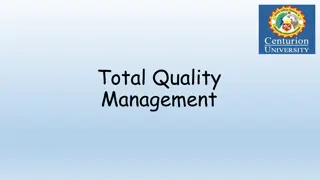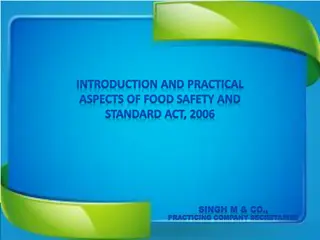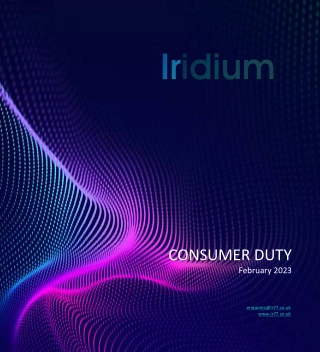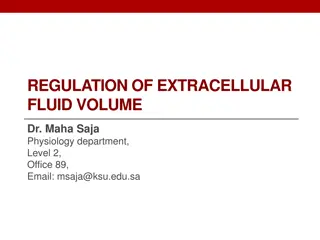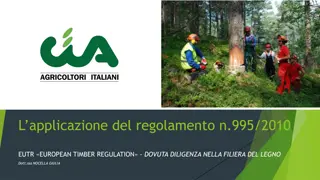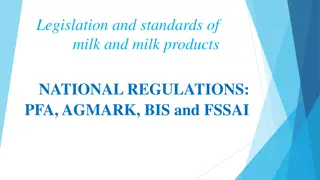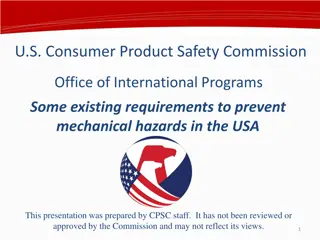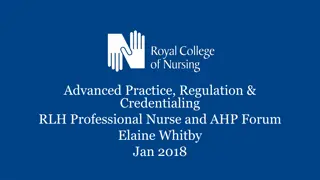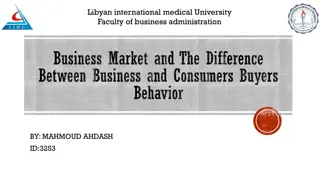Importance of Food Standards and Regulation in Ensuring Consumer Health
Food standards and regulations play a crucial role in safeguarding consumer health by protecting against health risks, ensuring product quality, and preventing fraud in the food industry. Organizations like NAFDAC in Nigeria oversee the regulation and control of food, drugs, and other regulated products to uphold public health standards.
Download Presentation

Please find below an Image/Link to download the presentation.
The content on the website is provided AS IS for your information and personal use only. It may not be sold, licensed, or shared on other websites without obtaining consent from the author. Download presentation by click this link. If you encounter any issues during the download, it is possible that the publisher has removed the file from their server.
E N D
Presentation Transcript
NTD 404 : Food Standards Talabi, J.Y
Food Laws Food foods. Theyare designed to: 1. Protect the health of the consumer. The production, processing, transport, handling and sale of food stuffs may create dangers for consumer s health. 2. Protect the consumer against fraud. Regulations are issued to ensure that the consumer, receives the product he/she legitimately expects paying special attention to the packaging and labelling of the product. laws govern the production, handling and marketing of
Food Standards Food standards are defined as a body of rules that concern food right from ingredient assembly to finished products. Food standards are integral components of food laws. Food standards are designed : to prevent transmission of diseases to the product; to protect the health of the consumers and to limit the sales of unfairproducts. Types of food standards National standards are those formulated by the national bodies of a country. In Nigeria, Standard Organization of Nigeria(SON) and National Agency for Food and Drug Administration and Control(NAFDAC) are responsible in dishing outvarious standards for foods and drugs.
National Agency For Food and Drug Administration and Control(NAFDAC) The body was formerly Administration(FDA) NAFDAC was thus established by Decree No 15 of 1993 as a parastatal of the Federal Ministry of Health to carry out among other things, all the control functions of the former FDA while the service functions remain within the ministry. The mandate of NAFDAC is to ensure the quality, safety and efficacyof food, drugs and all regulated product. Thevision is to safeguard the public health of the nation The mission is to safeguard the public health by ensuring that only right quality food, drugs and other regulated products are manufactured, exported, imported and advertised, sold and used. known as Food and Drugs
Functionsof NAFDAC Regulate and control the importation, exportation, manufacture, advertisement, distribution, sale and use of drugs, cosmetics, medical devices, packaged waterand chemicals. Conduct appropriate tests and ensure compliance with standard specifications designed and approved by the council for the effective control of quality of food, drugs, cosmetics, medical devices, packaged waterand chemicals. Undertake appropriate investigation premises and raw materials for food, drugs, cosmetics, medical devices, bottled water and chemicals and establish a relevant quality assurance system, including production sites and of the regulated products. Compile standard specifications, regulations and guidelines for the production, importation, exportation, sale and distribution of food, drugs, cosmetics, medical devices, bottled water and chemicals. into the production certification of the
Undertake the registration of food, drugs, medical devices, bottled waterand chemicals Control the exportation and issue quality certification of food, drugs, medical devices, bottled water and chemicals intended for export Establish and maintain relevant laboratories or other institutions in strategic areas of Nigeria as may be necessary for the performance of its functions. This agency is expected to have its office in every state capital in the country.
The standard Organisation of Nigeria(SON) SON was formed in 1971. In 1984, the Organisation changed the name to standards Organisation of Nigeria (SON) from Nigeria Standards Organisation (NSO) to eliminate conflicting identity with the then Nigerian Security Organisation. In 1990, SON was conferred partial autonomy from the Ministry of industry. The work of Standard Organization of Nigeria is to investigate the quality of facilities, materials and products in Nigeria, and establish a quality assurance system, including certification of factories, products and laboratories. The standards organization of Nigeria (SON) is the apex standardization body in Nigeria. SON was established by SON Act No.14, 2015, which repeals the Standards Organisation of Nigeria Act, Cap 59 laws of Federal Republic of Nigeria, 2004.
Functions of SON To standardise methods of analyses for different products both edibleand non-edible. To establish standards for different products manufactured in the country. To establish standards in respect of weight and measurement in the country. To advice the Federal Government generally on the national policy on standard specifications, methodology To establish and quality awareness system including certification of factories, products and laboratories. Improvement of measurement accuracy and circulation of information relating to standards. As at today, the SON has set standards for many products in Nigeriaand more are still emerging from thevarious laboratories quality control and
International Food Standards Food standards are developed on an international level by various international organizations Commission and International Standards Organisation (ISO). CodexAlimentarius Commission The Codex Alimentarius (Latin for "Food Code") is a collection of internationally recognized standards, codes of practice, guidelines, and other recommendations relating to foods, food production, and food safety Its name is derived from the Codex Alimentarius Austriacus. Its texts are developed and Alimentarius Commission, a body that was established in early November 1961 by the Food and Agriculture Organization of the United Nations (FAO), was joined by the World Health Organization (WHO) in June 1962, and held its first session in Rome in October 1963. such as Codex Alimentarius maintained by the Codex
The Commission's main goals are to protect the health of consumers and ensure fair practices in the international food trade. The Codex Alimentarius is recognized by the World Trade Organization as an international the resolution of disputes concerning food safety and consumer protection. The Codex Alimentarius covers all foods, whether processed, semi-processed or raw. In addition to standards for Alimentarius contains general standards covering matters such as food labeling, food hygiene, food additives and pesticide residues and procedures for assessing the safety of foods derived from modern biotechnology It also contains guidelines for the management of official i.e. governmental import and export inspection systems for foods. reference point for specific foods, the Codex and certification
Contents of the Codex Allimentarius The Codex Alimentarius Commission establishes international food quality standards through a thirteen-volume publication, the Codex Alimenntarius, to facilitate world trade. The contents are: 1A.General requirements 1BGeneral requirements (Food hygiene) 2APesticide residues in foods (general) 2BPesticide residue in foods (maximum residue limits) 3 Residues of veterinary drugs in foods 4 Foods forspecial dietary uses 5A Processed and quick-frozen fruits and vegetables 6 Fruit juices 7 Cereals, pulses (legumes) and derived products and vegetable proteins 8 Fats and oils and related products
9 Fish and fishery products 10 Meat and meat products, soups and broths 11 Sugars, cocoa products and chocolate and miscellaneous soups and broth. 12 Milk and milk products 13 Methods of analysis and sampling











